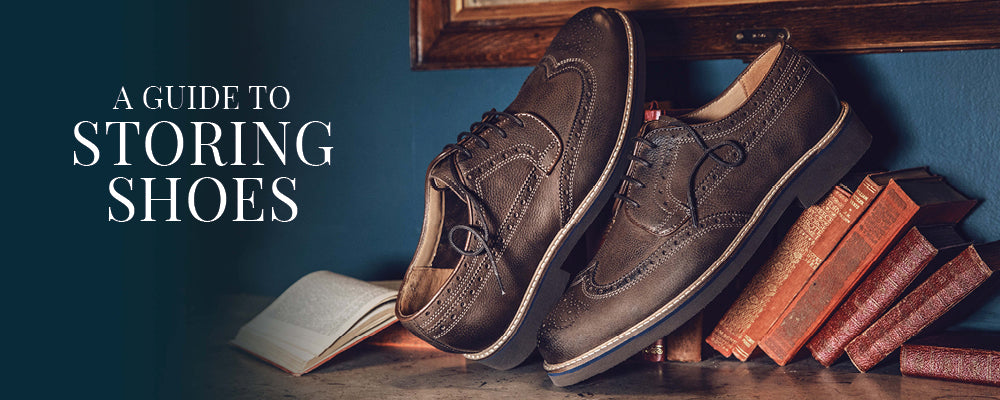How to Store Your Shoes
Posted by Jones Bootmaker on
A gathering pool of high heels at the bottom of your wardrobe. A tidal wave of trainers cascading from the cupboard under the stairs. An overflowing rack of muddy boots by the back door and a steady trickle of new shoes entering your home. Every footwear aficionado understands the overwhelm … but it doesn’t need to be this way.
Organising out shoe collections can give us lasting satisfaction, by revolutionising our living space and simultaneously removing the unnecessary fluff from our minds. Then there’s the wonder of rediscovering a pair of forgotten favourites that, with some new-found love and attention, can be reintroduced into our wardrobe.
When you take the time to look after shoes, they can last you a lifetime, so storing your footwear correctly can pay homage to your most admired pair of shoes and will make them feel brand new all over again.
If you’re wondering how to organise your wardrobe to store your shoes efficiently, we’ve put together a need-to-know guide on how to revolutionise your space and your prized footwear collections.
How to Organise Shoes
1. Declutter Your Shoe Collection
Gather your shoes and start by sorting into three piles, the ones you want to keep, the ones that can be recycled, and those that can be passed on to a new home. An effective way to purge your hoard is to follow the one-year rule, if you haven’t worn them in a year and you have no intention of wearing them anytime soon, get rid.
Most charity shops will gladly take donations of pre-loved shoes, or you can donate to Shoe Aid, a charity that promises to give those in need with a well-fitting pair of pre-loved shoes. Knowing that your pre-loved shoes are going to someone who needs them is just another benefit of letting them go.
2. Organise Your Shoes into Categories
With the shoes you want to keep, we recommend sorting them into further categories, such as:
Frequent use – For year-rounders such as your work heels and slip-on trainers.
Occasional use – For party heels and other smart shoes that only come out once or twice a month, which need to be out of the way of your busy day-to-day life, but readily accessible when needed at a moment’s notice.
Seasonal use –For the shoes that are currently out of season. Sandals can be put aside in deep storage during the winter months, and the same can be said for boots in the summertime. Storing your shoes by season means you can cycle your shoes in and out as needed. Use boot shapers and shoe trees to preserve the shape and quality of your shoes when they’re not in use.
Tip - Whatever categories you choose, make sure it makes sense to you and don’t be afraid to tweak your system as you go.

3. Find a designated space for each category
For frequent use shoes, we recommend a shoe rack or open-faced cupboard by the front door. Wherever you choose will ideally be somewhere your shoes are close at hand, out of direct sunlight (which can bleach shoes of their colour) and somewhere air can circulate around your shoes to prevent mould and unpleasant smells.
Using a shoe rack
Not only will displaying your shoes on a rack make them quick to grab on a busy weekday morning, having an accessible means of storing your shoes makes your efforts to tidy up in the present easy to maintain in the future.
Storing shoes in your wardrobe
For occasional shoes, consider keeping them in your wardrobe or cupboard. To prevent a pool of shoes gathering at the bottom of your wardrobe, wrap them in acid free paper, and place them in shoe or storage boxes on the top shelf to prevent them from being crushed. For added efficiency, and to prevent you from having to rifle through boxes when trying to find the perfect pair of shoes to match your outfit, print out a photo of your shoes and stick it to the side of the corresponding storage box so you can spot the correct pair.

Putting shoes in deep storage
For your seasonal shoes, consider a deep storage solution. To keep your shoes safe until the change of season, wrap clean shoes in acid-free tissue paper or pop them in a cotton draw-string shoe bag, and nestle them carefully in a container that makes the most sense for the space you’re working with.
Under-bed fabric organisers are a great option, especially those already split into shoe-sized compartments. With these organisers, shoes can be hidden away under the bed, protected from dust, sunlight, and other elements that cause weakened leather and cracked glue.
Stackable plastic containers are also a good choice if you’re looking to store your shoes in a cupboard. Just add a couple of silica packets to the bottom of each storage container to help maintain the correct moisture level.
4. Store your shoes correctly
Location is important. Try to avoid harsh climates like the attic, garage, or basement which can cause damage to shoes over time, particularly those shoes made of organic material such as leather and cork.
In instances where your shoes are unlikely to be worn for more than a week (mainly occasional and seasonal shoes) make sure they are clean and dry before putting them in storage. No one wants to spend time scrubbing year-old mud from their premium leather boots!
To help maintain the structure of your shoes place them on a shoe tree. Adjustable shoe trees are best and worth the investment as they can be used to fit and preserve different style and size shoes across the seasons.

How to Store Shoes
- Always clean before storing.
- Stuff with acid-free tissue paper or a shoe tree to maintain shape - being careful not to over-stretch the shoe.
- Wrap in acid-free tissue paper and nestle shoes in their original cardboard shoe box or other storage container.
- Alternatively, opt for a cotton shoe bag, and store shoes in an under-bed storage container, or hanging wardrobe caddy.
- Where possible, place shoes flat on their outsoles and avoid stacking shoes on top of one another as this will cause distortion and damage.
How to Store Boots
- Clean before storing.
- Use boot shapers to prevent collapsing or creasing.
- Lay flat in under-bed storage or stand upright in wardrobe or cupboard.
- Never leave the calves of your knee-high boots flopped over to one side as this can cause permanent damage.
-
Boot shapers offer the best support for calf or knee length boots since they’re contoured specifically to fit the tailored shape of the boot. If you’re looking for an alternative, rolled up magazines and even empty wine bottles work a treat.

How to Store Heels
- Heels can be stored in their original or other storage boxes, with a piece of acid free tissue paper separating each shoe from the other to prevent scratching.
- Shoe bags are best for protecting finer materials such as suede or patent leather. Tissue paper is best for beaded, embellished, or glitter heels.
- Fasten buckles or zip before storing, to prevent snagging and to maintain the shoe’s silhouette.
- If storing on a shelf, stand upright on a flat surface. Don’t stack other shoes on top as stilettos or the sharp edges of block heels can mark finer materials.
- Store your best heels high up, don’t let them sit at the bottom of your wardrobe, cupboard, or drawer, unless they’re packed away neatly in a protective box.

How to store trainers
- Make sure trainers are clean and dry before storing.
- Some canvas shoes can be cleaned in the washing machine, just trap the laces in the machine door to save your shoes from being bashed about. With leather or other smooth material uppers, simply wipe clean.
- Tuck laces into the shoes to prevent snagging or tangling.
- Store in their original or other storage boxes, wrapped in acid-free tissue paper or cotton shoe bags.
- Add silica packets to the storage box or shoe bag to maintain the correct moisture level and to keep your trainers looking, smelling, and feeling fresh.






